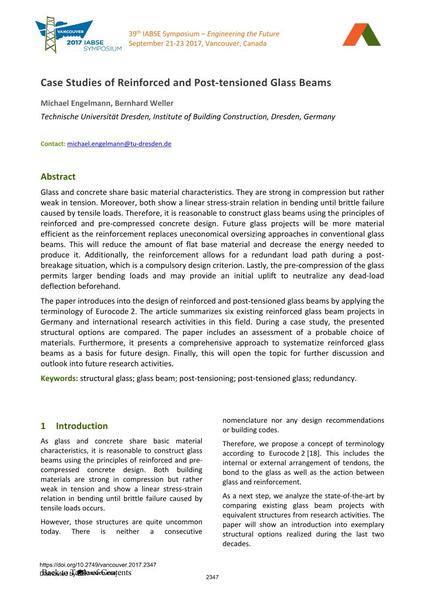Case Studies of Reinforced and Post-tensioned Glass Beams

|
|
|||||||||||
Bibliographic Details
| Author(s): |
Michael Engelmann
(Technische Universität Dresden, Institute of Building Construction, Dresden, Germany)
Bernhard Weller (Technische Universität Dresden, Institute of Building Construction, Dresden, Germany) |
||||
|---|---|---|---|---|---|
| Medium: | conference paper | ||||
| Language(s): | English | ||||
| Conference: | IABSE Symposium: Engineering the Future, Vancouver, Canada, 21-23 September 2017 | ||||
| Published in: | IABSE Symposium Vancouver 2017 | ||||
|
|||||
| Page(s): | 2347-2353 | ||||
| Total no. of pages: | 7 | ||||
| Year: | 2017 | ||||
| DOI: | 10.2749/vancouver.2017.2347 | ||||
| Abstract: |
Glass and concrete share basic material characteristics. They are strong in compression but rather weak in tension. Moreover, both show a linear stress-strain relation in bending until brittle failure caused by tensile loads. Therefore, it is reasonable to construct glass beams using the principles of reinforced and pre-compressed concrete design. Future glass projects will be more material efficient as the reinforcement replaces uneconomical oversizing approaches in conventional glass beams. This will reduce the amount of flat base material and decrease the energy needed to produce it. Additionally, the reinforcement allows for a redundant load path during a post- breakage situation, which is a compulsory design criterion. Lastly, the pre-compression of the glass permits larger bending loads and may provide an initial uplift to neutralize any dead-load deflection beforehand. The paper introduces into the design of reinforced and post-tensioned glass beams by applying the terminology of Eurocode 2. The article summarizes six existing reinforced glass beam projects in Germany and international research activities in this field. During a case study, the presented structural options are compared. The paper includes an assessment of a probable choice of materials. Furthermore, it presents a comprehensive approach to systematize reinforced glass beams as a basis for future design. Finally, this will open the topic for further discussion and outlook into future research activities. |
||||
| Keywords: |
redundancy post-tensioning structural glass glass beam post-tensioned glass
|
||||
